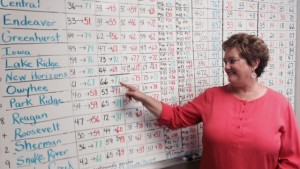Nampa elementary teachers have stopped giving students grades.
No report cards. No As or Fs. No bell curve results.
No averages, comparisons or percentages.
The Nampa School District has switched to assessing elementary students on what they know instead of what they can do.
For the second year in a row, the 14 elementary schools will use a “progression report” — not a traditional “report card” — to communicate to parents a child’s progress toward learning goals or a mastery of a specific standard, based on the Idaho Core Standards.

“It’s exciting work,” said Nancy Chopko, Nampa’s director of elementary education. “I truly believe in this.”
Nampa isn’t the first to change the way students are evaluated or assessed, but it is one of the first in Idaho to take a district-wide approach. It was important to Chopko that every school use the same standards and assessments because “we have a lot of mobility and this way kids and parents have consistency.”
Last year’s roll out was successful, but not without challenges. There was push back from some teachers and communication hurdles with parents.
“We have to get teachers to change their way of thinking and that isn’t easy,” Chopko said. “I believe every child can achieve these standards no matter the teacher, the school or what happens at home. It’s all about the kids and what they can learn.”
The district has not moved toward report changes in secondary education because colleges still require letter grades for entrance applications.
“What does a grade really tell parents?
Chopko explains a grade tells parents what a child can do, from their ability to test well, memorize or complete regular or extra credit assignments.
She said when her son got a “B” in math, that didn’t demonstrate to her what he learned. He simple got an overall grade. What did he still need to learn to get an A as opposed to what assignments were missing to get an A?
“What was I supposed to help him with?” Chopko said.
Traditional letter grades compare student performances (bell curve) and grades reflect averages of work done over time. For example, if a student scores 40, 60 and 80 on tests the student averages a 60. But the student may actually have met the standards because the scores reflect “progression” or forward movement of learning.
“An average grade doesn’t show what you know it only shows what you average,” Chopko said. “Letter grades are a great way to compare kids but not a great way to show what they know.”
Nampa’s progression reports
Nampa parents and students receive a report showing progress toward mastery of a specific standard. Progress is judged on a proficiency scale of 1 to 4 — 1 (limited proficiency); 2 (approaching standards); 3 (meets standards) and 4 (exceeds standards).
The reports are grade-level specific and have nearly 40 standards that students are required to meet by the end of the school year. Here are some examples of standards for third graders in Nampa:
- In writing, can research a topic using note taking strategies
- In reading, can ask and answer questions using evidence from the text
- In math, can determine the unknown number in a multiplication or division equation
- In measurement, can use a ruler to measure halves and fourths of an inch.
These documents for each grade level took months to create using committees that included administrators, teachers, parents and trustees. They answered these questions in the process of developing standards and progression reports:
- What do we want them to know?
- How do we know if they know it?
- What do we do if they don’t know it?
- What do we do if they already know it?
“A lot of work went into these and a lot of people were involved,” Chopko said.
The purpose of a progression report, they determined, was to track students as the progressed toward mastering standards. Students should gradually move from earning “1s” early in the year to “3s” (or meets standards) by the end of the year. Earning a “4” (exceeds standards) should be extremely rare because the goal is to meet standards and therefore move on to the next set of standards.
“It can be difficult to get everyone on the same page but it’s exciting to think we can potentially all be aligned,” said Tammy Stefan, Nampa’s English language arts coordinator.
Chopko has shared Nampa’s progression reports with other Idaho districts interested in transforming report cards.
“The trick is communicating with parents and it happens best at conferences,” said Cindy Dion, Nampa’s elementary math coordinator. Dion said she’s not heard from any parents who would like to go back to letter grades.
Characteristics of successful students
Another piece to the progression reports is called “characteristics of successful students.” In this section, parents can learn about a student’s behavior. Here are examples of these standards:
- Work independently
- Complete and return homework on time
- Show positive attitude for learning
Before, characteristics were included in the earning of a traditional grade. Now, those are separate so a student’s behavior is not reflected in a report that is to designed to illustrate what a student knows.
“They are different things — we want to see progression toward learning and behavioral goals measured separately,” Chopko said.
Chopko, 65, could have retired five years ago but she’s so passionate and so convinced in mastery learning that she’s taken this project on as “my baby” instead of spending time with her already retired husband.
“I love this stuff,” she said. “I’m a strong advocate for those kids who need more support.
“I tell my teachers to put excuses in a box and set it aside. Because if a child can’t read, we’ve decided their future for them.”
